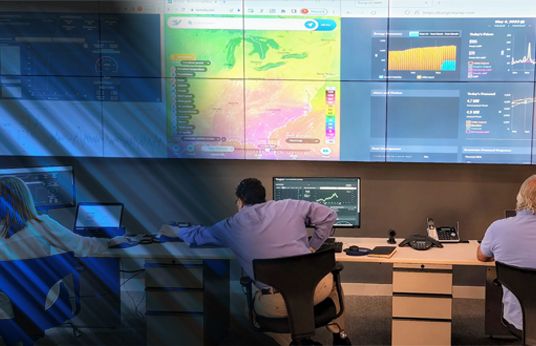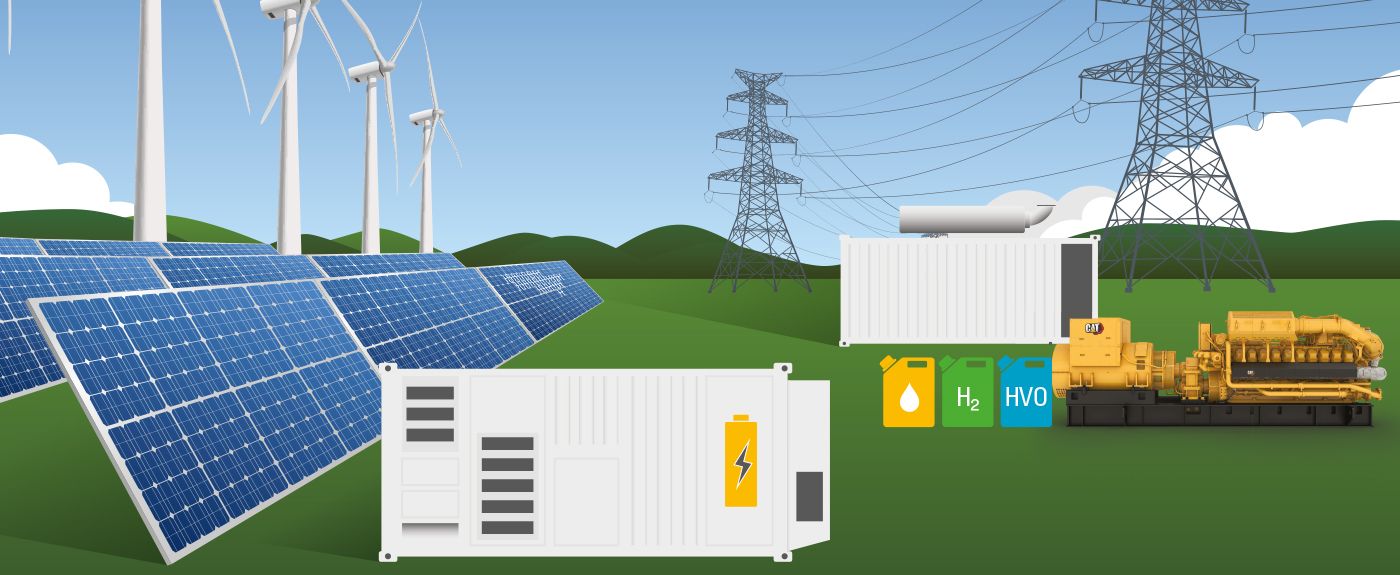

Sign In
Welcome! Sign In to personalize your Cat.com experience
If you already have an existing account with another Cat App, you can use the same account to sign in here
Register Now
One Account. All of Cat.
Your Caterpillar account is the single account you use to log in to select services and applications we offer. Shop for parts and machines online, manage your fleet, go mobile, and more.
Account Information
Site Settings
Security
How Municipal Utilities Can Address
Surging Power Demand
By Brian Poe, Business Development Manager, Caterpillar Electric Power
Over the course of my 16-year career in the energy business, I’ve spent a fair amount of time in conversation with municipal utility managers. Here’s the key thing I’ve learned: As individuals, you’re as different as the communities you represent — small/large, conservative/progressive, rural/urban. But as a group, you’re united around a common purpose, keeping the power on and the price reasonable for those you serve. The fact that your customers are your families, friends and neighbors probably drive much of that accountability.
Unfortunately, for many municipal utility managers I talk to, it’s getting tougher to continue providing the highest levels of reliability, service, and value. Customer preferences are changing. Some want 100% renewable power overnight; others simply care about cost. Other challenges are mounting, too: New technologies. Increased regulation. Workforce shortages. Budget constraints. And perhaps biggest of all, rising demand.
The big question: how can you address it? Here are four strategies I’ve seen other municipalities employ to tackle the challenge — and start seeing results fast.
Strategy #1: Upgrade existing assets
The Challenge: Colby, Kansas, is a growing city of 6,000 residents and a regional hub for healthcare, shopping, entertainment, and education. The city is connected to grid power but still operates a public power plant built in 1910 for backup needs. The equipment inside was old and outdated, requiring lots of time and manual labor to maintain and bring online.
The Solution: Colby Public Power team invested in new, easy-to-maintain generators compliant with current emissions standards and electronic controls to start them up with the push of a button.
The Outcome: When Winter Storm Uri hit the area in 2021, electricity costs soared. Colby started up its updated power plant fast, saving the community about $1.7 million.
Strategy #2: Plan ahead to combat rising costs and emissions targets
The Challenge: Reading Municipal Light Department (RMLD) serves 80,000 residents and 3,000+ commercial and industrial customers in the Boston suburbs. The utility expects its electrical load to double over the next 25 years and is rethinking how power is generated since the Massachusetts climate bill calls for zero emissions by 2050.
The Solution: RMLD implemented a series of gas power generation assets with Distributed Energy Resource Management software which remotely monitors energy system signals and predicts opportunities to reduce costs.
The Outcome: The solution has led to $4 million in net savings to customers.
Strategy #3: Bridge the gap between traditional and renewable power
The Challenge: Deseret Power is a regional generation and transmission cooperative in Utah, where long-term drought conditions have limited the amount of hydroelectric power available.
The Solution: Needing additional sources of generation, Deseret Power broke ground on a 15 MW solar project along with a 15 MW power plant fueled by natural gas generator sets.
The Outcome: Operated remotely from 400 miles away, this “virtual” plant delivers fast, flexible power in a volatile market. It serves as a backstop when renewable power isn’t available due to weather. And Deseret Power can bring the plant online instantly to help mitigate changes in industry pricing or address a transmission outage.
Strategy #4: Pilot new energy solutions to prove out the benefits
The Challenge: Liberty’s utility operations span the U.S., serving more than a million customers nationwide. With increasing energy consumption, Liberty wants to implement alternative solutions to ensure resiliency.
The Solution: In New Hampshire, the utility is piloting battery storage to reduce peak load during high-demand times, provide backup power during outages and offer customers time-of-use rates. For the pilot, Liberty installed 2,600 kWh of lithium-ion battery storage at 100 homes to charge overnight when demand and rates are low. A distributed energy resource management system analyzes the energy industry then dispatches power from the batteries when it makes the most financial sense.
The Outcome: Liberty is saving more than $180,000 annually — and participating customers are seeing their monthly utility costs drop $60 on average, too.
Sounds good? What’s next for you?
At Caterpillar, we’ve been helping municipal utilities deliver reliable, cost-effective power solutions for decades. In recent years, that’s included several projects like the examples shared above. Our team of experts works in the background to meet your goals, while you maintain that all-important direct relationship with your customers. We’d love to discuss your goals and challenges, then talk about a plan that could deliver resiliency, revenue and possibly even carbon reduction for your community. Click here if you’d like one of our experts to contact you.

Brian Poe
Business Development Manager
Caterpillar Electric Power
Brian Poe, business development manager, has more than 15 years of industry expertise in pioneering solutions in the ever-evolving landscape of alternative power and energy transition. Working with customers in utilities, municipalities and cooperatives, Brian is dedicated to understanding the unique needs of his clients, providing strategic guidance and empowering leaders with forward-thinking solutions that not only address their current challenges but also position them for a resilient and sustainable energy future.
Generate Savings and Economic Dispatch
Reduce electricity costs and increase energy market program participation with Energy as a Service (EaaS) solutions. Automatically dispatch on-site assets to generate and store energy with an industry-leading technology platform and energy resource management services.

Related Stories
-
Act Now to Leverage CHP Tax Credits Up to 50%
The Inflation Reduction Act (IRA), signed into law in August 2022, provides nearly $400 billion in tax credits and incentives over a decade to promote climate change mitigation and stimulate clean energy development in the U.S. It’s the largest single investment in climate and energy in American history — and it includes the highest incentives ever provided by the federal government for combined heat and power (CHP) projects.
Learn More -
5 Steps to Sign-Off on a New Energy Solution
You’re a large energy consumer, maybe in healthcare, education, distribution or transportation. You’re facing pressure — internal, external or both — to increase your energy resiliency, lower your carbon emissions, reduce your energy costs, add capacity for expansion, or some combination of all four. You know you need to act (and soon), but you’re struggling with how to get started implementing a solution.
Learn More -
Is Your Organization a Good Fit for EaaS? And Is Your EaaS Partner a Good Fit for You?
Our EaaS team at Caterpillar has implemented solutions for all types of operations: from K-12 schools and grocery stores to industrial facilities. The concept — you purchase energy outcomes and turn ownership and upkeep of energy assets over to a third party — works for many organizations. How do you know if yours is one of them?
Learn More -
Demystifying the EaaS Model: Don’t Buy Power Products. Buy Energy Outcomes.
Software as a Service, or SaaS. Today, most applications — everything from Microsoft Office to Google Drive to Salesforce — are hosted by a third-party provider and made available via the web or a mobile app. You don’t need to install or configure anything on your computer, and the SaaS provider handles all maintenance, upgrades, and licensing. It’s more convenient for users and more affordable for businesses.
Learn More -
Hydrogen’s True Colors: A Key to Defining Carbon Intensity
Often referred to as a “clean-burning” fuel, hydrogen is the most abundant chemical substance in the universe because its combustion generates near-zero greenhouse gas emissions at the tailpipe. . It’s also colorless, odorless and burns with a near-invisible flame. So why does nearly every Google search or news story about hydrogen turn up terms like “green,” “blue” and even “pink”?
Learn More -
Distributed Energy Benefits and Grid Systems Integration
Our electric power system faces many challenges, and as the energy landscape evolves to address increased electrification, we will have even greater demand than ever before. Caterpillar is positioned to serve as a trusted partner with the technologies and expertise to provide alternatives to established energy sources and fuels that are reliable and cost effective.
Learn More -
Trends in the Energy Transition
When it comes to the ongoing efforts to decarbonize and reduce greenhouse gas (GHG) emissions, renewables are making up more and more of our sources of power generation, and we think this will continue—for many positive reasons. We have a lot of customers who are setting targets for Environmental, Social, and Governance (ESG) goals, aiming for improved carbon reduction.
Learn More









